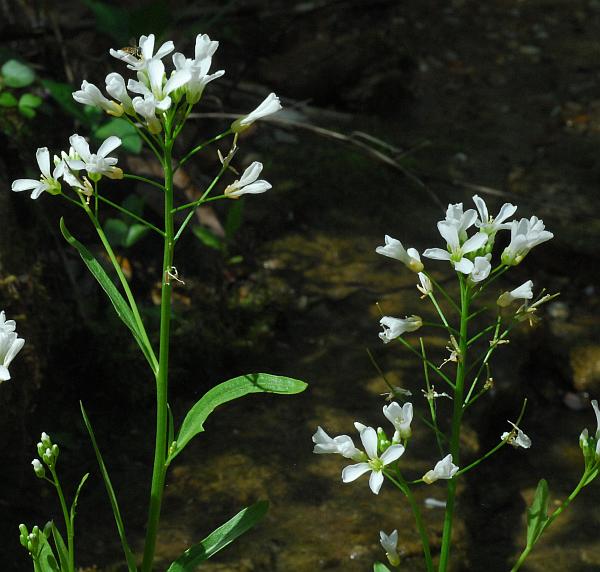Cardamine bulbosa (Schreb. ex Muhl.) Britton, Sterns & Poggenb.
Springcress

Native
CC = 7
CW = -5
MOC = 62
© SRTurner
Cardamine bulbosa (Schreb. ex Muhl.) Britton, Sterns & Poggenb.Springcress | |
 |
Native CC = 7 CW = -5 MOC = 62 |
© SRTurner |
|
Family - Brassicaceae Habit - Perennial forb, occasionally emergent aquatic, with short, tuberous rhizomes, these unsegmented or occasionally irregularly constricted into 2 or 3 segments. Stems - Erect, to 60 cm, usually glabrous, occasionally with sparse, minute hairs in the apical half, green apically, purplish near the base, simple or branched above.
Leaves - Alternate, simple, glabrous. Basal leaves petiolate, typically purplish abaxially. Petioles to 7 cm long. Blades ovate, with undulate margins, tapering at the base or truncate, to 5 cm long, 2.5-3 cm broad. Stem leaves becoming sessile or short petiolate, with a few coarse teeth or entire, lanceolate to oblong-lanceolate.
Inflorescence - Terminal racemes, compact in flower, elongating in fruit. Pedicels glabrous, to 1.8 cm long.
Flowers - Sepals 4, 2.5-5.0 mm long, greenish yellow, glabrous, erect. Petals 4, 7-12 mm long, tapering to the base, rounded at apex, white, sometimes faintly pinkish-tinged, glabrous. Stamens 6, erect, 4 longer and 2 shorter. Filaments white, 5-6 mm long. Anthers 1.3 mm long, pale yellow. Ovary terete, 5 mm long, glabrous, yellow-green. Style 1.2 mm long. Stigma capitate.
Fruits - Siliques 20-30 mm long, sometimes aborting before maturity. Seeds 1.7-2.1 mm long, irregularly oblong to circular in outline, the surface slightly roughened, orange to greenish yellow.
Flowering - March - June. Habitat - Spring branches, wet meadows, pond margins, fens, bottomland forests, moist ledges of bluffs. Origin - Native to the U.S. Lookalikes - None close. Flowers are similar to those of Cardamine concatenata but the leaves are completely different. Other info. - This species can be found across most of Missouri, but is more common in the southern part of the state. It is fairly common in the eastern half of the continental U.S., but absent from the west. The plant likes to be in or near water and is easily identified by its rather large, 4-petaled white flowers. A closely related plant, C. douglassii, occurs in the northeast corner of the state, and is differentiated by having pink to purple petals. According to Yatskievych, the distinctness of this plant as a discrete species has been questioned. Photographs taken at Whetstone Conservation Area, Callaway County, MO., 4-28-04 (DETenaglia); also at Canaan Conservation Area, Gasconade County, MO, 5-16-2013 and 5-6-2014, Millstream Gardens Conservation Area, Madison County, MO, 4-28-2020, and Niangua Natural Area, Dallas County, MO, 4-22-2023 (SRTurner). |